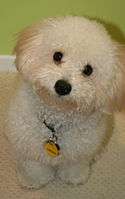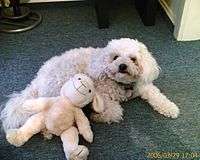Bolognese (dog)
 Bolognese | |||||||||||||||||||||||||||
| Other names |
Bichon Bolognese, the Bolognese Toy Dog, the Bologneser, Bolo, the Botoli, the Bottolo[1] | ||||||||||||||||||||||||||
|---|---|---|---|---|---|---|---|---|---|---|---|---|---|---|---|---|---|---|---|---|---|---|---|---|---|---|---|
| Origin | Italy | ||||||||||||||||||||||||||
| |||||||||||||||||||||||||||
| |||||||||||||||||||||||||||
| Notes | The AKC does not have its own standard but instead links to that of the FCI. | ||||||||||||||||||||||||||
| Domestic dog (Canis lupus familiaris) | |||||||||||||||||||||||||||
The Bolognese [boloɲˈɲeːze] is a small breed of dog of the bichon type, originating in Italy. The name refers to the central Italian city of Bologna. It is part of the Toy dog group and is considered a companion dog. They love attention, and make good house pets. They are good at socializing with other dogs, big and small. They have a strong bond with the person/s they spend time with most.
Description
Appearance
The Bolognese is a small, white, compact dog with a distinctive white single coat. It is of small size, stocky and compact. It is of square build and well-muscled. The head is of medium length. The skull is slightly ovoid.[2] The muzzle is large, black and almost square. It has a developed jaw and the upper lips don’t cover the bottom lips. Its lips are black. It has white, strong and evenly aligned teeth. Its eyes are well developed, open and round. The rims of the eyelids are black and the iris is a dark ochre color. The ears are set high and are long and hanging but rigid at the base. The tail is carried curved over the back.
The Bolognese's height varies 10.5 to 12 inches for a male and 10-11 inches for a female.[3] The weight varies between 6 and 14 lbs.[4]
Coat
The distinctive single coat (i.e. no undercoat) falls in loose open ringlets/flocks all over the body, with shorter hair on the face. The hair's texture is woolly, as opposed to silky, and is never trimmed or clipped unless kept as pets. The hair sheds very little, but requires regular combing to prevent matting.
The Bolognese often appears on lists of dogs that allegedly do not shed (moult). It is true that these dogs do not seasonally moult or lose large amounts of fur as many other breeds do. However, they do eventually lose and replace individual hairs, similar to human hair growth cycles. Each hair grows from a hair follicle, which has a three phase cycle, as do most mammals. These cycles are: anagen, growth of normal hair; catagen growth slows, and hair shaft thins; telegen, hair growth stops, follicle rests, and old hair fall off—is shed. At the end of the telegen phase, the follicle begins the cycle again.[5] The length of time of the growing and shedding cycle varies by age and other factors. There is no such thing as a completely non-shedding breed.[6]
The coat requires daily brushing with monthly grooming recommended.[3] Grooming must also include regular bathing, eye and ear hygiene and teeth cleaning.[7]
-

-

-

-

Bolognese puppy
Temperament
Trademark traits of the Bolognese include: playful, easygoing, earnest, willing, intelligent and loyal.[8] They are not hyperactive and are normally more reserved than the Bichon Frise.
The Bolognese is very responsive to obedience training. They are highly intelligent, quick to learn, and easy to train but can be very stubborn when they don’t get their way.[7] A Bolognese will quickly train to potty pads and a bell-ringing notification system for taking potty breaks outside.
The Bolognese genuinely enjoys companionship of people and forms a close relationship with his owner.They are true companions and thrive on their owner’s attention. They have been known to follow their owners wherever they go. They are friendly with strangers but need to get accustomed to people at a young age.[2] They can be reserved with strangers at first, but the response of the owners to the new person greatly influences their behavior towards the individual. Because of this, they are generally friendly towards strangers after the initial meeting. Bolognese are true watchdogs, but are not incessant barkers. They notice anything unusual and faithfully notify their owners. Bolognese get along well with other dogs but are happy to be the only dog in the family.[7] They are non-aggressive by nature.
Bolognese can be prone to small dog syndrome, human induced behaviors where the dog believes he is pack leader to humans. This can cause behavior programs including separation anxiety and timidity.They do not do well when left alone for long period of time.[7] They may protest vocally when the owner is busy and cannot pay attention to him or her, but a quick romp in the yard or tug-o-war in the play room will solve the issue.
Ideal owners of Bolognese include families with children, retirees, and city dwellers.[8] They are good with children as long as the children are old enough and mature enough to handle these dogs gently, carefully, and safely. They are not a good choice for younger children who can easily injure small dogs.[7]
History
They belong to the Bichon family group, which includes the Bichon Frise, Maltese, Lowchen, Havanese and Coton de Tulear. Although there are some similarities the Bolognese are a distinctive breed in their own right. The Bolognese is an ancient breed of noble origins, and has its roots with Italian Aristocracy.[9]
The precise ancestry of the Bolognese is a mystery. Its closest relative within the Bichon group is the Maltese but it is unclear as to whether the Maltese is its direct ancestor or descendant. The Bolognese are named after Bologna, a city in northern Italy, thought to be the place of their conception. The existence of the Bolognese has been recorded since the year 1200.[2]
They can be seen in tapestry work produced by Flemish craftsmen dating as far back as the 17th century. The Venetian painter Titian painted the Duke Frederico Gonzaga with his Bolognese. The breed is also seen in paintings by Goya, Gosse and Watteau. Other famous owners of the breed include Catherine the Great of Russia (1729-1796), Madame De Pompadour (1721-1764) and Empress Maria Theresa of Austria.[4]
The breed was brought into England in 1990 by Liz Stannard and is first shown during that year in the breed registry. In 2001 the breed was able to be shown at all shows with their own classes. They were at Crufts, an annual international dog show, for the first time in 2002.[10]
Activities
Exercise
While Bolognese are perfectly happy to lounge around the house, they should also have a daily walk.[8] A good walk would be around 20–25 minute a couple times a day or substitute 10-minute walks a few times a day.
Training
Bolognese are easy to train but are quick to bore with numerous repetitive drills. They thrive on variety so it is best to change or expand activities to keep them happily engaged and thinking. They respond well to positive reinforcement, gentle training methods and consistency. They do not respond well to shouting or harshness.
Health
Life span
The average life span of the Bolognese is 14 years.[11] They can live up to 10 years with relatively few genetic health issues.[8] They are known to still act puppy-like at 10 years of age and are able to maintain aspects of youthfulness throughout their lives. They are typically active well into their senior years.
Common health problems
Bolognese are typically a healthy breed and are not prone to any major problems.
See also
References
- ↑ from Go Pets America, Inc, retrieved 2009-04-16
- 1 2 3 "Bolognese". Retrieved April 13, 2012.
- 1 2 "Bolognese Dog Breed Information and Pictures". www.dogbreedinfo.com. Retrieved 2016-02-14.
- 1 2 "Bolognese "Not Just Another White Fluffy Dog"". Dogtime Media Network. Retrieved April 13, 2012.
- ↑ Evans, Howard E.; de Lahunta, Alexander (August 7, 2013). Miller's Anatomy of the Dog (Fourth ed.). Saunders. pp. 71–73. ISBN 978-1437708127.
- ↑ Skin & Hair Anatomy & Function in Dogs, by Race Foster, DVM, Drs. Foster & Smith, Inc./PetEducation.com
- 1 2 3 4 5 Schneider, Sandy. "Temperment [sic] of the Bolognese". www.bichonworld.com. Retrieved April 13, 2012.
- 1 2 3 4 "Bolognese Dogs". SAY Media, Inc. 2012, A Dogster Property. Retrieved April 13, 2012.
- ↑ Breed information, British Bolognese Club Archived July 14, 2014, at the Wayback Machine.
- ↑ "Bolognese: Did You Know?". 2012 American Kennel Club. Retrieved April 13, 2012.
- ↑ "Bolognese - PetGuide". PetGuide. Retrieved 2016-02-14.
External links
| Wikimedia Commons has media related to Bolognese. |